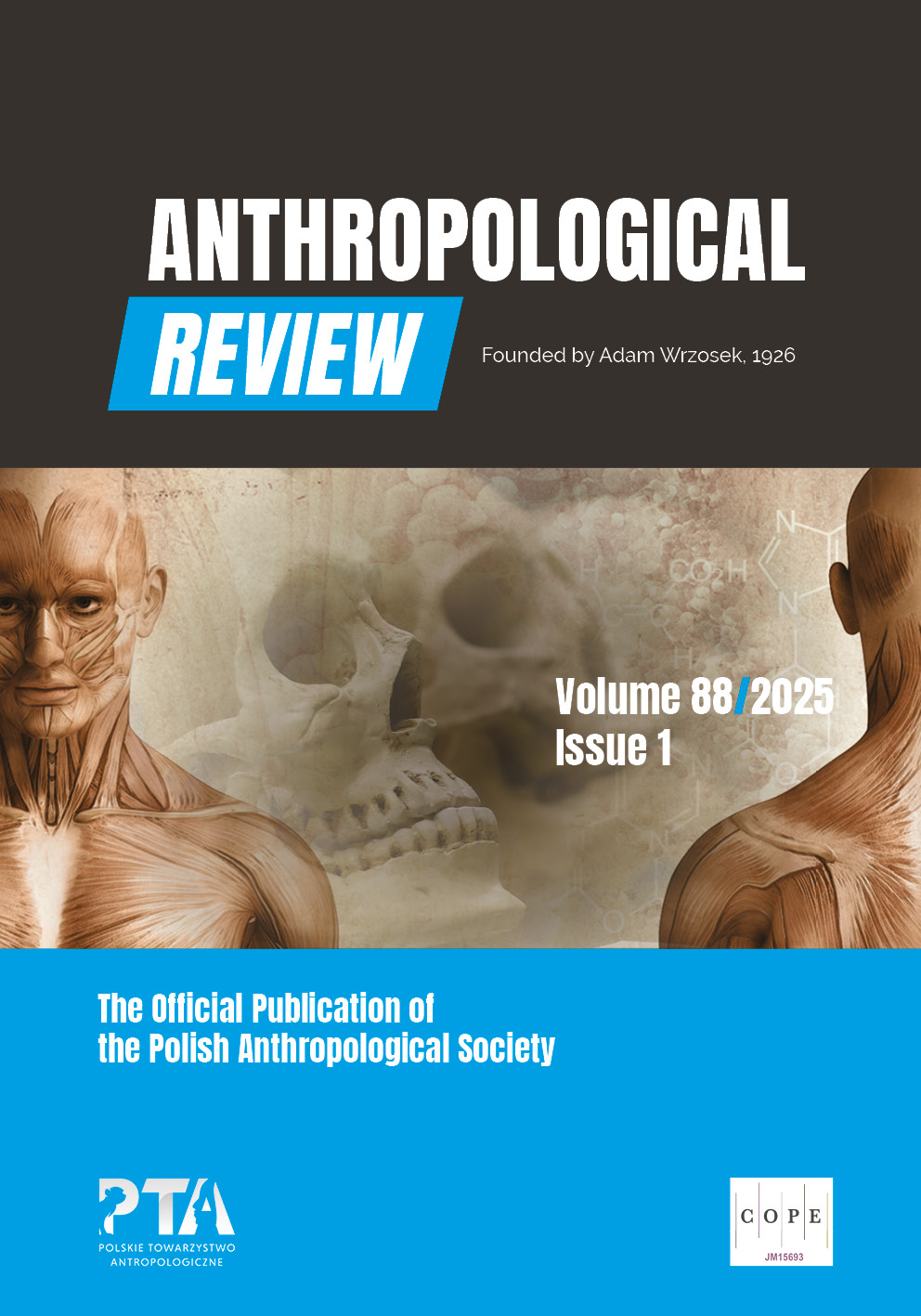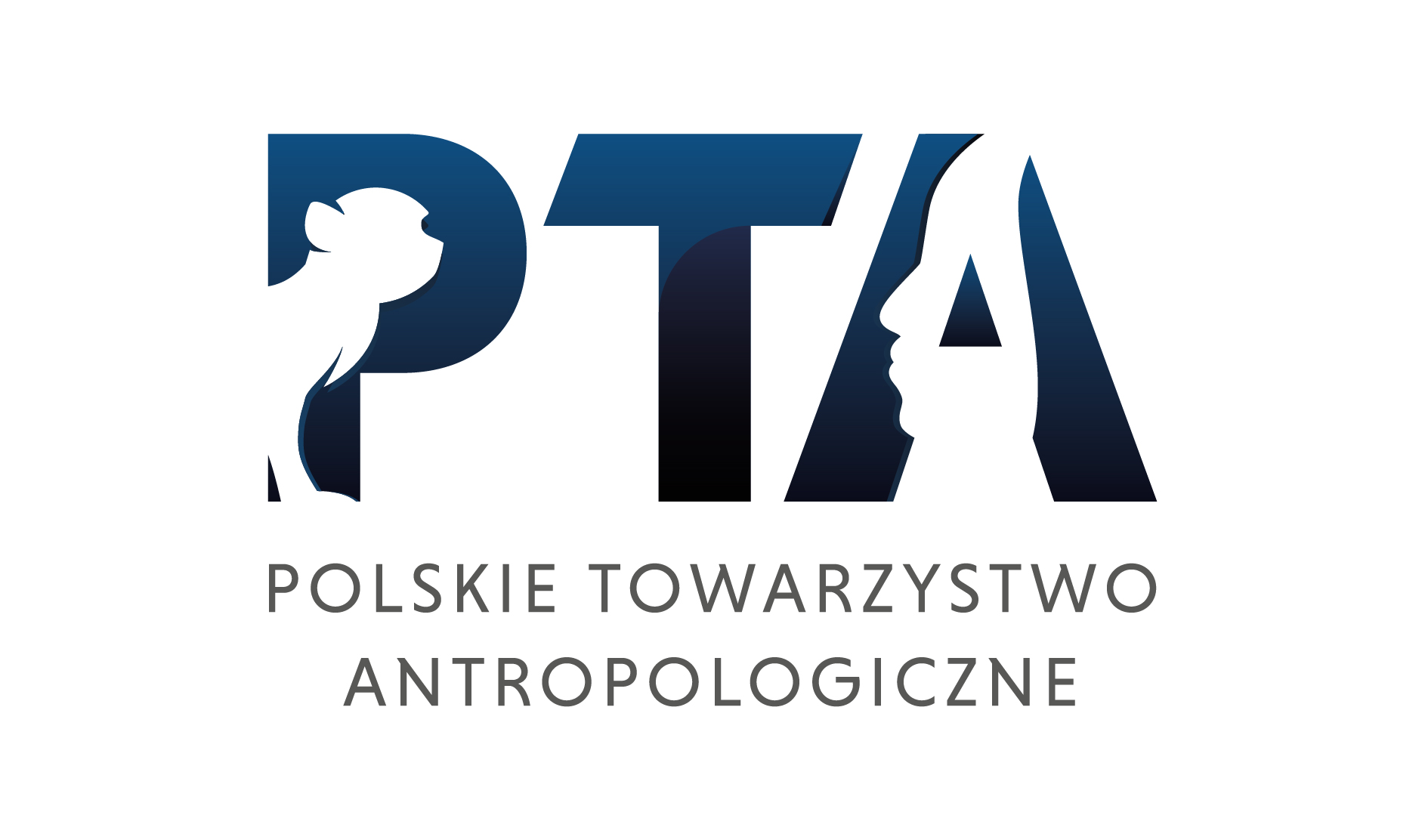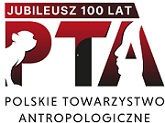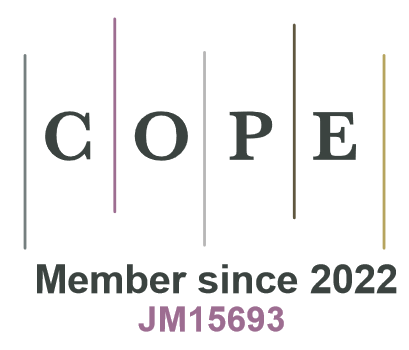Relationships between Sociosexuality and Dermatoglyphic Traits
DOI:
https://doi.org/10.18778/1898-6773.88.1.03Keywords:
radio-ulnar asymmetry, sex development, prenatal programming, sexual behavior, sex differencesAbstract
In humans, prenatal development of brain dispositions to sex differences in mating behavior is difficult to study directly. Indirect prenatal markers, including dermatoglyphics, present a viable option.
In this study we tested a hypothesis that some radio-ulnar contrasts in dermatoglyphic ridge counts could be related with human sociosexuality.
Sociosexual Orientation Inventory (SOI) data from 180 young adults, along with fingerprints of their terminal phalanges (via hand scanning) were collected, and relationships between SOI and dermatoglyphics were analyzed.
Typical sex differences in SOI were recorded with higher scores in males and lower in females. Among other results we found that on the index finger lower number of triradii and cores (i.e., mostly in loop type dermatoglyphic patterns) and radial-biased within-finger asymmetry in ridge counts typical for ulnar loops were connected with typical sex differences in SOI (higher in males and lower in females) while in subjects possessing an opposite dermatoglyphic arrangement – higher numbers of cores and triradii and ulnar-biased within-finger ridge count asymmetry typical in radial loops – sex differences in SOI scores disappeared. Recognized significant and systematic trends were mostly connected with variables derived from dermatoglyphic features on the 2nd and 4th fingers.
Possible relationships with prenatal androgen causation are discussed.
Downloads
References
Akbarova SN. 2018. Dermatoglyphics can be as method of behavior genetics. GESJ Educ Sci Psychol. 4(50):26–37.
View in Google Scholar
Al-Jumaily RMK, Lafta FM, Al-Dahiri LKI, Fadhil LZ. 2010. Digital dermatoglyphic characteristics in patients with sex hormones anomalies. J Al-Nahrain Univ. 13(2):164–9. https://doi.org/10.22401/JNUS.13.2.21
View in Google Scholar
DOI: https://doi.org/10.22401/JNUS.13.2.21
Alter M. 1965. Is Hyperploidy of Sex Chromosomes Associated with Reduced Total Finger Ridge Count? Am J Hum Genet. 17(6):473–75.
View in Google Scholar
Arnold AP. 2014. Conceptual frameworks and mouse models for studying sex differences in physiology and disease: Why compensation changes the game. Exp Neurol. 259:2–9. https://doi.org/10.1016/j.expneurol.2014.01.021
View in Google Scholar
DOI: https://doi.org/10.1016/j.expneurol.2014.01.021
Babler WJ. 1991. Embryologic Development of Epidermal Ridges and Their Configurations. Birth Defects Orig. Artic. Ser. 27(2):95–112.
View in Google Scholar
Bailey JM, Kirk KM, Zhu G, Dunne MP, Martin NG. 2000. Do individual differences in sociosexuality represent genetic or environmentally contingent strategies? Evidence from the Australian twin registry. J Pers Soc Psychol. 78(3):537–45. https://doi.org/10.1037/0022-3514.78.3.537
View in Google Scholar
DOI: https://doi.org/10.1037//0022-3514.78.3.537
Barrett ES, Parlett LE, Redmon JB, Swan SH. 2014. Evidence for sexually dimorphic associations between maternal characteristics and anogenital distance, a marker of reproductive development. Am J Epidemiol. 179(1):57–66. https://doi.org/10.1093/aje/kwt220
View in Google Scholar
DOI: https://doi.org/10.1093/aje/kwt220
Börger D, Held KR, Lüttgen S. 1986. Dermatoglyphics in Congenital Adrenal Hyperplasia (CAH). Clin Genet. 30(3):173–6. https://doi.org/10.1111/j.1399-0004.1986.tb00591.x
View in Google Scholar
DOI: https://doi.org/10.1111/j.1399-0004.1986.tb00591.x
Bracha HS, Torrey EF, Bigelow LB, Lohr JB, Linington BB. 1991. Subtle signs of prenatal maldevelopment of the hand ectoderm in schizophrenia: A preliminary monozygotic twin study. Biol Psychiatry 30(7):719–25. https://doi.org/10.1016/0006-3223(91)90017-G
View in Google Scholar
DOI: https://doi.org/10.1016/0006-3223(91)90017-G
Charles NE, Alexander GM. 2011. The Association Between 2D:4D Ratios and Sociosexuality: A Failure to Replicate. Arch Sex Behav. 40(3):587–95. https://doi.org/10.1007/s10508-010-9715-z
View in Google Scholar
DOI: https://doi.org/10.1007/s10508-010-9715-z
Clark AP. 2004. Self-perceived attractiveness and masculinization predict women’s sociosexuality. Evol Hum Behav, 25(2):113–24. https://doi.org/10.1016/S1090-5138(03)00085-0
View in Google Scholar
DOI: https://doi.org/10.1016/S1090-5138(03)00085-0
Cohen-Bendahan CCC, van de Beek C, Berenbaum SA. 2005. Prenatal sex hormone effects on child and adult sex-typed behavior: Methods and findings. Prenat Program Behav Physiol Cogn. 29(2):353–84. https://doi.org/10.1016/j.neubiorev.2004.11.004
View in Google Scholar
DOI: https://doi.org/10.1016/j.neubiorev.2004.11.004
Coll-Andreu M, Ayora-Mascarell L, Trullas-Oliva R, Morgado-Bernal I. 1989. Behavioral evaluation of the stress induced by the platform method for short-term paradoxical sleep deprivation in rats. Brain Res Bull. 22(5):825–28. https://doi.org/10.1016/0361-9230(89)90025-7
View in Google Scholar
DOI: https://doi.org/10.1016/0361-9230(89)90025-7
Cummins H, Midlo C. 1961. Finger prints, palms and soles. New York: Dover Publications, Inc.
View in Google Scholar
Del Cerro MCR, Ortega E, Gómez F, Segovia S, Pérez-Laso C. 2015. Environmental prenatal stress eliminates brain and maternal behavioral sex differences and alters hormone levels in female rats. Horm Behav. 73:142–47. https://doi.org/10.1016/j.yhbeh.2015.07.004
View in Google Scholar
DOI: https://doi.org/10.1016/j.yhbeh.2015.07.004
DeLecce TL, Polheber JP, Matchock RL. 2014. Sociosexual Orientation and 2D:4D Ratios in Women: Relationship to Men’s Desirability Ratings as a Long-Term Pair Bond. Arch Sex Behav. 43(2):319–27. https://doi.org/10.1007/s10508-013-0201-2
View in Google Scholar
DOI: https://doi.org/10.1007/s10508-013-0201-2
Fatjó-Vilas M, Gourion D, Campanera S, Mouaffak F, Levy-Rueff M, Navarro ME, Chayet M, Miret S, Krebs MO, Fañanás L. 2008. New evidences of gene and environment interactions affecting prenatal neurodevelopment in schizophrenia-spectrum disorders: A family dermatoglyphic study. Schizophr Res. 103(1–3):209–17. https://doi.org/10.1016/j.schres.2008.04.015
View in Google Scholar
DOI: https://doi.org/10.1016/j.schres.2008.04.015
Gluckman PD, Hanson MA editors. 2006. Developmental origins of health and disease. New York: Cambridge University Press.
View in Google Scholar
DOI: https://doi.org/10.1017/CBO9780511544699
Golembo-Smith S, Walder DJ, Daly MP, Mittal VA, Kline E, Reeves G, Schiffman J. 2012. The presentation of dermatoglyphic abnormalities in schizophrenia: A meta-analytic review. Schizophr Res. 142(1–3):1–11. https://doi.org/10.1016/j.schres.2012.10.002
View in Google Scholar
DOI: https://doi.org/10.1016/j.schres.2012.10.002
Green R, Young R. 2000. Fingerprint asymmetry in male and female transsexuals. Personal Individ Differ. 29(5):933–42. https://doi.org/10.1016/S0191-8869(99)00244-5
View in Google Scholar
DOI: https://doi.org/10.1016/S0191-8869(99)00244-5
Guo J, Wu C, Zhang J, Li W, Lv S, Lu D, Qi X, Feng C, Liang W, Chang X, Zhang Y, Xu H, Cao Y, Wang G, Zhou Z. 2021. Prenatal exposure to multiple phenolic compounds, fetal reproductive hormones, and the second to fourth digit ratio of children aged 10 years in a prospective birth cohort. Chemosphere 263:127877. https://doi.org/10.1016/j.chemosphere.2020.127877
View in Google Scholar
DOI: https://doi.org/10.1016/j.chemosphere.2020.127877
Hall JAY, Kimura D. 1994. Dermatoglyphic Asymmetry and Sexual Orientation in Men. Behav Neurosci. 108(6):1203–6. http://dx.doi.org/10.1037/0735-7044.108.6.1203
View in Google Scholar
DOI: https://doi.org/10.1037/0735-7044.108.6.1203
Hall LS. 2000. Dermatoglyphic Analysis of Total Finger Ridge Count in Female Monozygotic Twins Discordant for Sexual Orientation. J Sex Res. 37(4):315–20. https://doi.org/10.1080/00224490009552053
View in Google Scholar
DOI: https://doi.org/10.1080/00224490009552053
Hettmansperger TP, McKean JW. 2011. Robust Nonparametric Statistical Methods. 2nd edition. Boca Raton, FL: CRC Press, Taylor & Francis Group.
View in Google Scholar
DOI: https://doi.org/10.1201/b10451
Ho YYW, Evans DM, Montgomery GW, Henders AK, Kemp JP, Timpson NJ, St Pourcain B, Heath AC, Madden PAF, Loesch DZ, McNevin D, Daniel R, Davey-Smith G, Martin NG, Medland SE. 2016. Genetic variant influence on whorls in fingerprint patterns. J Invest Dermatol. 136(4):859–62. https://doi.org/10.1016/j.jid.2015.10.062
View in Google Scholar
DOI: https://doi.org/10.1016/j.jid.2015.10.062
Hocking RR. 2003. Methods and Applications of Linear Models. 2nd edition. Hoboken, New Jersey: John Wiley & Sons, Inc.
View in Google Scholar
Holt SB. 1951. The Correlation Betwen Ridge-counts on Different Fingers. Ann Eugen. 16(1):287–97. https://doi.org/10.1111/j.1469-1809.1951.tb02481.x
View in Google Scholar
DOI: https://doi.org/10.1111/j.1469-1809.1951.tb02481.x
Holt SB. 1961. Quantitative genetics of finger-print patterns. Br Med Bull. 17(3):247–50.
View in Google Scholar
DOI: https://doi.org/10.1093/oxfordjournals.bmb.a069917
Holt SB. 1979. Epidermal Ridge-counts. Coll Antropol. 3(1):97–106.
View in Google Scholar
Ingrová P, Králík M, Bártová V, Jandová M, Daňko M, Skalická E. 2018. Sociosexualita mladých dospělých: Změny w 21. Století, wpływ pohlaví a sexuální orientace. Čes Antropol. 68(1–2):18–34.
View in Google Scholar
Jantz RL. 2022. Finger ridge-counts correlate with the second to fourth digit ratio (2d:4d). Am J Hum Biol. 34(2): e23625. https://doi.org/10.1002/ajhb.23625
View in Google Scholar
DOI: https://doi.org/10.1002/ajhb.23625
Jantz RL, Hunt DR. 1986. The influence of sex chromosomes on finger dermatoglyphic patterns. Ann Hum Biol. 13(3):287–95. https://doi.org/10.1080/03014468600008461
View in Google Scholar
DOI: https://doi.org/10.1080/03014468600008461
Kahn HS, Graff M, Stein AD, Lumey LH. 2009. A fingerprint marker from early gestation associated with diabetes in middle age: The Dutch Hunger Winter Families Study. Int J Epidemiol. 38(1):101–09. https://doi.org/10.1093/ije/dyn158
View in Google Scholar
DOI: https://doi.org/10.1093/ije/dyn158
Kahn HS, Graff M, Stein AD, Zybert PA, McKeague IW, Lumey LH. 2008. A fingerprint characteristic associated with the early prenatal environment. Am J Hum Biol. 20(1):59–65. https://doi.org/10.1002/ajhb.20672
View in Google Scholar
DOI: https://doi.org/10.1002/ajhb.20672
Kahn HS, Ravindranath R, Valdez R, Narayan KMV. 2001. Fingerprint Ridge-Count Difference between Adjacent Fingertips (dR45) Predicts Upper-Body Tissue Distribution: Evidence for Early Gestational Programming. Am J Epidemiol. 153(4):338–44. https://doi.org/10.1093/aje/153.4.338
View in Google Scholar
DOI: https://doi.org/10.1093/aje/153.4.338
Kasielska-Trojan A, Manning JT, Kałuża M, Głowacka E, Antoszewski B. 2024. First trimester maternal sex steroids and the digit ratios of mothers and children. Early Hum Dev. 195:106067. https://doi.org/10.1016/j.earlhumdev.2024.106067
View in Google Scholar
DOI: https://doi.org/10.1016/j.earlhumdev.2024.106067
Kimura D, Carson MW. 1995. Dermatoglyphic asymmetry: Relation to sex, handedness and cognitive pattern. Personal Individ Differ. 19(4):471–78. https://doi.org/10.1016/0191-8869(95)00076-I
View in Google Scholar
DOI: https://doi.org/10.1016/0191-8869(95)00076-I
Kimura D, Clarke PG. 2001. Cognitive pattern and dermatoglyphic asymmetry. Personal Individ Differ. 30(4):579–86. https://doi.org/10.1016/S0191-8869(00)00056-8
View in Google Scholar
DOI: https://doi.org/10.1016/S0191-8869(00)00056-8
Kinsley CH, Bridges RS. 1988. Prenatal stress and maternal behavior in intact virgin rats: Response latencies are decreased in males and increased in females. Horm Behav. 22(1):76–89. https://doi.org/10.1016/0018-506X(88)90032-3
View in Google Scholar
DOI: https://doi.org/10.1016/0018-506X(88)90032-3
Kloke JD, McKean JW. 2012. Rfit: Rank-based estimation for linear models. R J. 4(2):57–64. https://doi.org/10.32614/RJ-2012-014
View in Google Scholar
DOI: https://doi.org/10.32614/RJ-2012-014
Králík M, Hupková A, Zeman T, Hložek M, Hlaváček L, Slováčková M, Čuta M, Urbanová P. 2019a. Family effects on the digit ratio (2D:4D): The role of the interbirth interval. Am J Hum Biol. 31(4): e23260. https://doi.org/10.1002/ajhb.23260
View in Google Scholar
DOI: https://doi.org/10.1002/ajhb.23260
Králík M, Katina S, Urbanová P. 2014. Distal Part of the Human Hand: Study of Form Variability and Sexual Dimorphism Using Geometric Morphometrics. Anthropol Integra 5(2):7–25. https://doi.org/10.5817/AI2014-2-7
View in Google Scholar
DOI: https://doi.org/10.5817/AI2014-2-7
Králík M, Klíma O, Polcerová L. 2017. Dermatoglyphix 1.0. Software. [English; Windows]. Masaryk University, Faculty of Science, Department of Anthropology. LaMorFA. http://www.sci.muni.cz/lamorfa/veda-a-vyzkum#projekty
View in Google Scholar
Králík M, Polcerová L, Čuta M. 2019b. Sex Differences in Frequencies of Dermatoglyphic Patterns by Individual Fingers. Ann Hum Biol. 46(3):231–45. https://doi.org/10.1080/03014460.2019.1622778
View in Google Scholar
DOI: https://doi.org/10.1080/03014460.2019.1622778
Kunter M, Rühl M. 1995. Seiten- und Geschlechtsunterschiede quantitativer Hautleistenbefunde der Fingerbeeren bei einer mitteleuropäischen Stichprobe (Grießen, Hessen). Anthropol Anz. 53(1):79–90.
View in Google Scholar
DOI: https://doi.org/10.1127/anthranz/53/1995/79
Kücken M. 2007. Models for fingerprint pattern formation. Forensic Sci Int. 171(2–3):85–96. https://doi.org/10.1016/j.forsciint.2007.02.025
View in Google Scholar
DOI: https://doi.org/10.1016/j.forsciint.2007.02.025
Lippa RA. 2007. The relation between sex drive and sexual attraction to men and women: A cross-national study of heterosexual, bisexual, and homosexual men and women. Arch Sex Behav. 36(2):209–22. https://doi.org/10.1007/s10508-006-9146-z
View in Google Scholar
DOI: https://doi.org/10.1007/s10508-006-9146-z
Lippa RA. 2009. Sex Differences in Sex Drive, Sociosexuality, and Height across 53 Nations: Testing Evolutionary and Social Structural Theories. Arch Sex Behav. 38(5):631–51. https://doi.org/10.1007/s10508-007-9242-8
View in Google Scholar
DOI: https://doi.org/10.1007/s10508-007-9242-8
Liu C, Xu X, Zhang Y, Li W, Huo X. 2016. Associations between maternal phenolic exposure and cord sex hormones in male newborns. Hum Reprod. 31(3):648–56. https://doi.org/10.1093/humrep/dev327
View in Google Scholar
DOI: https://doi.org/10.1093/humrep/dev327
Loesch DZ. 1983. Quantitative dermatoglyphics – classification, genetics, and pathology. Oxford: Oxford University Press.
View in Google Scholar
Lyons MJ, Koenen KC, Buchting F, Meyer JM, Eaves L, Toomey R, Eisen SA, Goldberg J, Faraone SV, Ban RJ, Jerskey BA, Tsuang MT. 2004. A Twin Study of Sexual Behavior in Men. Arch Sex Behav. 33(2):129–36. https://doi.org/10.1023/B:ASEB.0000014327.11433.66
View in Google Scholar
DOI: https://doi.org/10.1023/B:ASEB.0000014327.11433.66
Mangiafico SS. 2015. An R Companion for the Handbook of Biological Statistics. Version 1.3.8, revised 2023. http://rcompanion.org/rcompanion/index.html
View in Google Scholar
Manning JT. 2002. Digit Ratio: A Pointer to Fertility, Behavior, and Health. New Jersey: Rutgers University Press.
View in Google Scholar
Manning JT, Scutt D, Wilson J, Lewis-Jones DI. 1998. The ratio of 2nd to 4th digit length: A predictor of sperm numbers and concentrations of testosterone, luteinizing hormone and oestrogen. Hum Reprod. 13(11):3000–04.
View in Google Scholar
DOI: https://doi.org/10.1093/humrep/13.11.3000
Millard SP. 2013. EnvStats: An R Package for Environmental Statistics. Springer.
View in Google Scholar
DOI: https://doi.org/10.1007/978-1-4614-8456-1
Mitsui T, Araki A, Miyashita C, Ito S, Ikeno T, Sasaki S, Kitta T, Moriya K, Cho K, Morioka K, Kishi R, Shinohara N, Takeda M, Nonomura K. 2016. The Relationship between the Second-to-Fourth Digit Ratio and Behavioral Sexual Dimorphism in School-Aged Children. PLOS ONE 11(1):e0146849. https://doi.org/10.1371/journal.pone.0146849
View in Google Scholar
DOI: https://doi.org/10.1371/journal.pone.0146849
Mitsui T, Araki A, Miyashita C, Ito S, Ikeno T, Sasaki S, Kitta T, Moriya K, Cho K, Morioka K, Kishi R, Shinohara N, Takeda M, Nonomura K. 2019. Effects of prenatal sex hormones on behavioral sexual dimorphism. Pediatr Int. 61(2):140–46. https://doi.org/10.1111/ped.13756
View in Google Scholar
DOI: https://doi.org/10.1111/ped.13756
Mulvihill JJ, Smith DW. 1969. The genesis of dermatoglyphics. J Pediatr. 75(4):579–89. https://doi.org/10.1016/S0022-3476(69)80453-1
View in Google Scholar
DOI: https://doi.org/10.1016/S0022-3476(69)80453-1
Mustanski BS, Bailey M, Kaspar S. 2002. Dermatoglyphics, Handedness, Sex, and Sexual Orientation. Arch Sex Behav. 31(1):113–22. https://doi.org/10.1023/a:1014039403752
View in Google Scholar
DOI: https://doi.org/10.1023/A:1014039403752
Penke L, Asendorpf J. 2008. Beyond Global Sociosexual Orientations: A More Differentiated Look at Sociosexuality and Its Effects on Courtship and Romantic Relationships. J Pers Soc Psychol. 95(5):1113–35. https://doi.org/10.1037/0022-3514.95.5.1113
View in Google Scholar
DOI: https://doi.org/10.1037/0022-3514.95.5.1113
Penrose LS. 1963. Finger-Prints, Palms and Chromosomes. Nature 197(4871):933–38. https://doi.org/10.1038/197933a0
View in Google Scholar
DOI: https://doi.org/10.1038/197933a0
Penrose LS. 1967. Finger-print pattern and the sex chromosomes. The Lancet 289(7485):298–300. https://doi.org/10.1016/S0140-6736(67)91237-8
View in Google Scholar
DOI: https://doi.org/10.1016/S0140-6736(67)91237-8
Polani PE, Polani N. 1979. Dermatoglyphics in the testicular feminization syndrome. Ann Hum Biol. 6:417–30. https://doi.org/10.1080/03014467900003811
View in Google Scholar
DOI: https://doi.org/10.1080/03014467900003811
Polcerová L, Chovancová M, Králík M, Beňuš R, Klíma O, Meinerová T, Čuta M, Petrová ME. 2022a. Radioulnar contrasts in fingerprint ridge counts: Searching for dermatoglyphic markers of early sex development. Am J Hum Biol. 34(5):e23695. https://doi.org/10.1002/ajhb.23695
View in Google Scholar
DOI: https://doi.org/10.1002/ajhb.23695
Polcerová L, Jantz RL, Králík M, Chovancová M, Čuta M. 2023. Sex differences in radioulnar contrasts of the finger ridge counts across 21 human population samples. Ann Hum Biol. 50(1):370–89. https://doi.org/10.1080/03014460.2023.2247970
View in Google Scholar
DOI: https://doi.org/10.1080/03014460.2023.2247970
Polcerová L, Králík M, Meinerová T, Chovancová M, Čuta M. 2022b. Meta-analysis of radioulnar contrasts in dermatoglyphic ridge-counts between individual fingers. Anthropol Integra 13(1):39–52. https://doi.org/10.5817/AI2022-1-39
View in Google Scholar
DOI: https://doi.org/10.5817/AI2022-1-39
Puts DA, Pope LE, Hill AK, Cárdenas RA, Welling LLM, Wheatley JR, Breedlove SM. 2015. Fulfilling desire: Evidence for negative feedback between men’s testosterone, sociosexual psychology, and sexual partner number. Horm Behav. 70:14–21. https://doi.org/10.1016/j.yhbeh.2015.01.006
View in Google Scholar
DOI: https://doi.org/10.1016/j.yhbeh.2015.01.006
Qazi QH, Thompson MW. 1971. Dermatoglyphics in Congenital Virilizing Adrenal Hyperplasia. Am J Dis Child. 122(1):28–30. https://doi.org/10.1001/archpedi.1971.02110010064009
View in Google Scholar
DOI: https://doi.org/10.1001/archpedi.1971.02110010064009
R Core Team. 2019. R: A Language and Environment for Statistical Computing. R Foundation for Statistical Computing. https://www.R-project.org/
View in Google Scholar
Sanders G, Sjodin M, de Chastelaine M. 2002. On the elusive nature of sex differences in cognition: Hormonal influences contributing, to within-sex variation. Arch Sex Behav. 31(1):145–52. https://doi.org/10.1023/A:1014095521499
View in Google Scholar
DOI: https://doi.org/10.1023/A:1014095521499
Schaumann B, Alter M. 1976. Dermatoglyphics in Medical Disorders. New York-Heidelberg-Berlin: Springer-Verlag.
View in Google Scholar
DOI: https://doi.org/10.1007/978-3-642-51620-7
Schmitt DP. 2005. Sociosexuality from Argentina to Zimbabwe: A 48-nation study of sex, culture, and strategies of human mating. Behav Brain Sci. 28(2):247–75. https://doi.org/10.1017/S0140525X05000051
View in Google Scholar
DOI: https://doi.org/10.1017/S0140525X05000051
Schwidetzky I, Jantz RL. 1977. Rassenunterschiede der Geschlechtsdifferenzierung von Hautleistenmerkmalen. Mitteilungen Anthropol Ges Wien 107:182–87.
View in Google Scholar
Schwidetzky I, Jantz RL. 1979. Race differences in the sex dimorphism of dermatoglyphic traits. J Hum Evol. 8(8):773–76. https://doi.org/10.1016/0047-2484(79)90006-X
View in Google Scholar
DOI: https://doi.org/10.1016/0047-2484(79)90006-X
Simpson J, Gangestad S. 1991. Individual differences in sociosexuality: Evidence for convergent and discriminant validity. J Pers Soc Psychol. 60(6):870–83. https://doi.org/10.1037/0022-3514.60.6.870
View in Google Scholar
DOI: https://doi.org/10.1037//0022-3514.60.6.870
Slabbekoorn D, van Goozen SHM, Sanders G, Gooren LJG, Cohen-Kettenis PT. 2000. The dermatoglyphic characteristics of transsexuals: Is there evidence for an organizing effect of sex hormones. Psychoneuroendocrinology 25(4):365–75. https://doi.org/10.1016/S0306-4530(99)00063-3
View in Google Scholar
DOI: https://doi.org/10.1016/S0306-4530(99)00063-3
van Anders SM, Hamilton LD, Watson NV. 2007. Multiple partners are associated with higher testosterone in North American men and women. Horm Behav. 51(3):454–59. https://doi.org/10.1016/j.yhbeh.2007.01.002
View in Google Scholar
DOI: https://doi.org/10.1016/j.yhbeh.2007.01.002
Velazquez-Moctezuma J, Salazar ED, Cruz Rueda ML. 1993. The effect of prenatal stress on adult sexual behavior in rats depends on the nature of the stressor. Physiol Behav. 53(3):443–48. https://doi.org/10.1016/0031-9384(93)90137-5
View in Google Scholar
DOI: https://doi.org/10.1016/0031-9384(93)90137-5
Vonk R, van der Schot AC, van Baal GCM, van Oel CJ, Nolen WA, Kahn RS. 2014. Dermatoglyphics in relation to brain volumes in twins concordant and discordant for bipolar disorder. Eur Neuropsychopharmacol. 24(12):1885–95. https://doi.org/10.1016/j.euroneuro.2014.09.010
View in Google Scholar
DOI: https://doi.org/10.1016/j.euroneuro.2014.09.010
Wong WI, Hines M. 2016. Interpreting digit ratio (2D:4D)–behavior correlations: 2D:4D sex difference, stability, and behavioral correlates and their replicability in young children. Horm Behav. 78:86–94. https://doi.org/10.1016/j.yhbeh.2015.10.022
View in Google Scholar
DOI: https://doi.org/10.1016/j.yhbeh.2015.10.022
Downloads
Published
Versions
- 13-05-2025 (2)
- 02-04-2025 (1)
How to Cite
Issue
Section
License

This work is licensed under a Creative Commons Attribution-NonCommercial-NoDerivatives 4.0 International License.
Funding data
-
Masarykova Univerzita
Grant numbers MUNI/A/1400/2018









